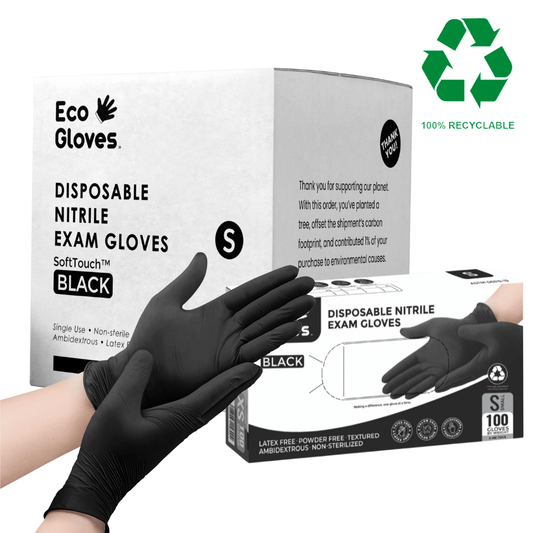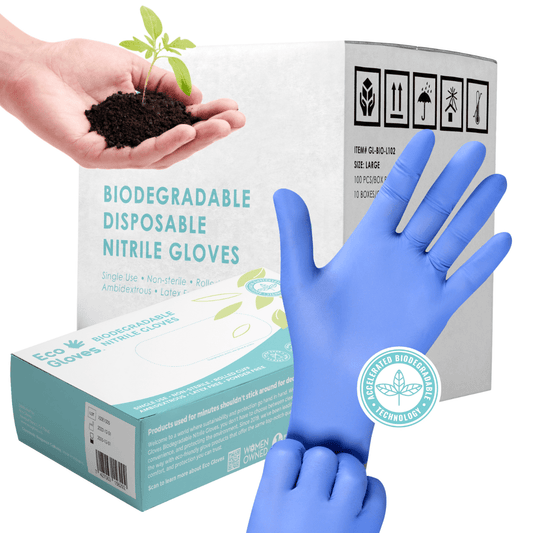What are Biodegradable Disposable Plastic Gloves?
Eco Gloves
The problem? Landfills of disposable plastic, latex, and nitrile gloves.
An estimated 4 billion disposable gloves are used per year and are exponentially on the rise. Good health starts with clean hands, but our environment and planet shouldn't have to suffer.
The solution? Eco-friendly, biodegradable, and compostable disposable gloves.
Say goodbye to waste. Plastic materials take centuries to breakdown naturally in the environment. New advancements in biopolymer materials, which are plant based plastic substitutes that can decompose naturally in the environment. How does it work? Natural microorganisms break down the glove material in conditions that are typically warm, moist, and directly exposed to sunlight.
While biodegradable plastics are perceived to be more eco-friendly, it is first important to understand the background behind the material, the factory, and the process being used to create a truly eco-friendly product such as Eco Gloves.
Topics Covered
- When were Biodegradable Plastics Invented?
- How are Biodegradable Gloves made?
- How to Biodegradable Gloves Break Down?
- How is Waste Minimized?
- How does this Help the Environment?
- Key Takeaways: Biodegradable Disposable Plastic Gloves
-
Frequently Asked Questions
When were Biodegradable Plastics Invented?
The first bioplastics company was created in the 1980s, but it wasn’t until the early 2000s that bioplastics began to be commercially used.
How are Biodegradable Gloves made?
Eco Gloves are made from 100% renewable raw materials or all-natural plant materials such as corn, cassava, tapioca roots, sugarcane, or sugar beet pulp. These vegetable based materials replace the petroleum-based plastics of today. The benefits of these biopolymers are that they're non-toxic, eco-friendly, recyclable, compostable, biodegradable, and better processed.
New advancements in manufacturing allow for a low time consumption for production and a high molecular weight final product. Even in high-performance and demanding applications, biodegradable glove alternatives are a good fit.
Eco Gloves are made from corn starch. Because of this, during the manufacturing process, energy is saved and less carbon is emitted because the plants used already have the same amount of carbon. Less energy is needed, 65% less than traditional petroleum products. Manufacturing bioplastics also do not require the process of finding, accessing, and transportation of hydrocarbons. Therefore, fewer fossil fuels are used, a lower carbon footprint, and less pollution in the environment. It is estimated that 68% fewer greenhouse gases are produced, a significant environmental benefit.
How to Biodegradable Gloves Break Down?
The secret is our additives that speed up the rate of decay or breakdown in the presence of oxygen and light. Moisture also accelerates the breakdown process. Most gloves will break down only in the presence of the sun's UV light or with high industrial-scale temperatures.
Eco Gloves are also easy to recycle. They are non toxic since they have no chemicals or toxins. The recycled bio-waste can be used as compost or renewable energy for biogas.
How is Waste Minimized?
Biodegradable gloves break down in only a period of a few months, this reduces the millions of trash produced annually each year.
How does this Help the Environment?
Less petroleum. Oil is a significant ingredient in manufacturing plastics. There is waste during refinement and also the energy to extract oil from the earth. Since biodegradable products are natural, it lessens the environmental hazards.
Key Takeaways: Biodegradable Disposable Plastic Gloves
-
Biodegradable disposable gloves are made from plant-based materials like corn, cassava, or sugarcane instead of petroleum-based plastics.
- These gloves decompose naturally under warm, moist, and sunlit conditions, reducing landfill waste in just a few months.
- Eco Gloves are non-toxic, compostable, and recyclable, with no harmful chemicals left behind.
- Manufacturing bioplastics uses up to 65% less energy and produces 68% fewer greenhouse gases than traditional plastics.
- Breaking down with the help of natural microorganisms, these gloves can be turned into compost or biogas for renewable energy.
- Using biodegradable gloves reduces reliance on fossil fuels, lowers carbon emissions, and minimizes environmental pollution.
Frequently Asked Questions
-
What materials are used to make biodegradable plastic gloves?
They are typically made from renewable plant-based materials such as corn starch, cassava, tapioca, sugarcane, or sugar beet pulp.
-
How long do biodegradable gloves take to decompose?
Unlike traditional plastic gloves that take centuries, biodegradable gloves can break down within a few months under the right environmental conditions.
-
Are biodegradable gloves compostable?
Yes—many biodegradable gloves, including Eco Gloves, can be composted and turned into nutrient-rich soil or processed into renewable energy like biogas.
-
Do biodegradable gloves perform as well as regular plastic gloves?
Yes—modern bioplastics provide durability, flexibility, and functionality suitable for demanding applications, while still being eco-friendly.
-
How do biodegradable gloves help reduce pollution?
They reduce petroleum use, cut greenhouse gas emissions, and leave no toxic residue after breaking down, minimizing harm to the environment and wildlife.
-
Can biodegradable gloves be recycled?
Yes—Eco Gloves are non-toxic and recyclable, and the recycled bio-waste can be repurposed into compost or renewable energy.
Further Reading
- Are Biodegradable Gloves Really Better for the Planet?
-
Understanding ASTM D6400: What It Means for Compostable Gloves
-
How to Properly Dispose of Disposable Gloves
- Compostable vs. Biodegradable: What’s the Difference?















